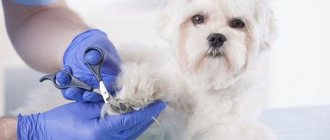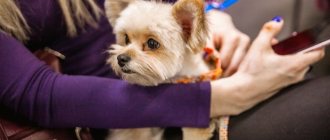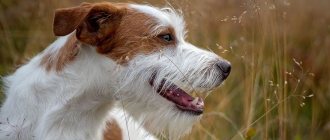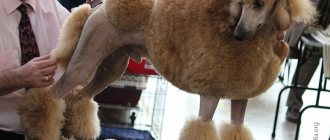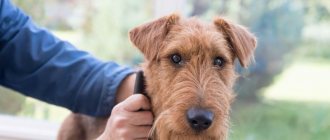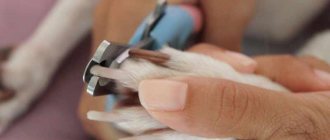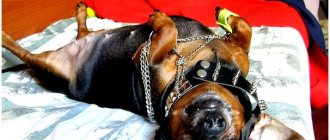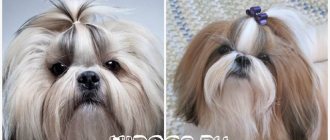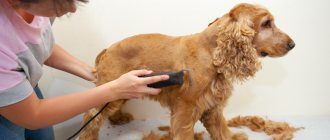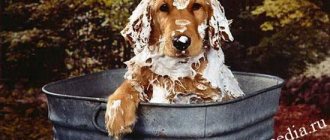Any caring owner monitors the health of his pet, improves his appearance, brings and maintains cleanliness and beauty. The set of procedures for caring for a pet is grooming.
Photo: Dog Grooming During the times of active use of horses in England, the person responsible for the appearance of a thoroughbred horse was called a groom, hence the name of the profession “groomer”. Nowadays, competent grooming specialists are in great demand, because all dogs need grooming - both decorative dogs, show purebred “aristocrats”, and just pets.
We can say that grooming was invented not by people, but by representatives of the animal world. Many animals look after each other - licking, scratching their backs, biting, showing care and emphasizing a strict hierarchy in relationships.
Grooming can be home - pet (English: pet) and professional . Every responsible owner is involved in pet grooming in one way or another - washing the paws, combing them, bathing them, treating them for parasites, etc. This, of course, helps to establish a trusting relationship with the dog, but it requires certain knowledge and time. In addition, you will still have to spend money on courses or books on grooming, on the necessary tools and care cosmetics.
Professional grooming allows you to:
- The result of the work of a professional groomer. Photo: mary
- determine the necessary procedures
- choose the right grooming products that are best suited for this type of coat
- act in accordance with breed standards, which is important when preparing a dog for an exhibition
- use the right, convenient tools and equipment
- fix the situation if something goes wrong (or the owner will be compensated for the damage)
- don’t waste your time, don’t worry about the result and don’t bother with cleaning the room
- It’s easy to find contact with your pet and calm it down if the animal is scared of an unfamiliar place
- call a specialist home (some groomers work on-site), and it will cost less than a salon
- apply the skills and abilities of a professional to guarantee proper and safe care
So what is grooming?
Some people think that grooming is a non-trivial name for a regular haircut for dogs. But this opinion is wrong, since this procedure involves not only hairdressing treatment of wool. This is a whole complex for caring for the appearance of the animal. Some dogs (we are talking about short-haired breeds) do not require a haircut at all, but this does not mean that they do not need grooming. After all, no one canceled cutting nails, brushing teeth, ears and bathing.
So what is grooming?
In general, every dog needs a comprehensive grooming procedure. The specialist who is responsible for all this “action” is called a groomer. Of course, each of them can supplement the list of manipulations with additional services, as well as offer a wide range of tools for carrying them out.
Not only groomers can arrange salon treatments for dogs, but also the owners themselves at home. To do this, they need to know what types of grooming there are, how they are carried out and what their differences are.
Myth No. 6: To prevent your pet from biting and scratching, it is better to put him under anesthesia
Anesthesia is often recommended for cats. It is almost impossible to comb, remove tangles or brush a cat’s teeth without scratching. But it is important to remember that anesthesia is a risk, so your pet must first have an ultrasound of the heart.
The minimum that needs to be done before anesthesia is to listen to the heart. Practice shows that even after testing and excellent blood, heart, liver and kidney parameters, there is a risk of cardiac arrest from anesthesia. I recommend carefully checking the animal’s body to reduce risks as much as possible.
Anatoly Krivoy, veterinarian
Grooming and its types
The goals of grooming vary. Some owners prepare their dogs for an exhibition, others want their dog to be known as a “neat guy,” and still others want a creative and extraordinary appearance for their pet. Depending on the intent of the cosmetic procedures, there are several types of grooming:
- Hygienic.
- Home.
- Exhibition.
- Creative.
Hygienic. Includes a hygienic haircut (cutting hair in the groin and under the tail) once every 2 weeks - 1 month. It is advisable to do it before swimming. After trimming, it will be easier for the owner to care for the animal. In this case, a haircut along the body is not expected. This method of cutting hair is suitable for dogs in several situations:
- If the dogs belong to breeds that do not need a full haircut. These include both fluffy varieties: huskies, huskies, shepherds, and smooth-haired animals: Dobermans, Dalmatians, bull terriers.
- If the dog is not yet fully grown after the haircut, but needs light hygienic care. Some breeds undergo this procedure between haircuts to always remain well-groomed and look great. Such “dandies” include: poodles, Scotch terriers, Spitz, Pekingese.
- If the animal constantly participates in exhibitions. Accordingly, it requires regular hygienic care between haircuts. Most often this applies to breeds with full-length hair - Maltese, Shihtzu, Yorkie.
In addition to the “sanitary” haircut, hygienic grooming includes a set of standard procedures: cleaning the ears and removing excess hair from them, cleansing the eyes, teeth, trimming the nails. Much attention is paid to the paws. Excess hair is trimmed between the toes and pads, and the hair on the limbs is shortened in a circular manner.
Grooming and its types
Home. It is considered a type of hygienic grooming, therefore it follows the same scheme and rules. Conducted by the dog owners themselves. But there is one “but” - for hygiene procedures you will have to stock up on a set of special tools for combing, cutting and trimming, and nail clippers. You also need to get all kinds of shampoos, conditioners and conditioners for dogs. True, zoological online stores have special grooming kits. They will make it easier to care for your dog at home.
Home grooming has one important feature. Its main goal is to give the dog a neat appearance, make it visually attractive and clean. In this case, it is not necessary to adhere to the breed’s conformation standards. A haircut is done more for the sake of hygiene and convenience, rather than for exhibition “beauty”.
Exhibition. But for this type of grooming, the entire procedure is performed strictly according to established rules. Moreover, when making an exhibition version, the master strives to maximally emphasize the advantages of the exterior, and, of course, tries to make the disadvantages of the four-legged appearance invisible. But all these manipulations are carried out in accordance with the requirements of the breed.
Creative. There are not and cannot be any rules, norms or restrictions. After all, when ordering such a service, the owner wants to give his dog’s exterior the most extravagant look. This is done mainly through original curly haircuts, when intricate patterns are cut on the animal’s fur.
There are other techniques through which groomers manage to turn even an ordinary dog into a work of art: dyeing the fur, adding decorative elements - rhinestones, feathers. Some experts are so keen on the creative option that they create dogs that look like pandas, dragons, dinosaurs and cartoon characters.
Varieties
Experts divide grooming for dogs into 4 main categories:
- Exhibition - requires professionalism, special skills and is carried out in specialized salons. Masters know all the features of a particular breed, they know how to highlight the advantages and hide the shortcomings of the animal. Not only the victory, but also the dog’s participation in the exhibition largely depends on grooming.
- Hygienic - a set of basic grooming procedures (trimming nails, trimming fur between paw pads, cleaning eyes, teeth, ears, bathing). It is carried out at least once every month.
- Creative - original haircut and coloring options for dogs. Recommended for pet owners who love everything unusual and extravagant. Not suitable for animals taking part in exhibitions and competitions.
- Home - includes procedures identical to those in the salon. Conducted at home, on your own. Helps save time and budget. However, to fully care for a pet, the owner will have to purchase a set of necessary tools, cosmetics and hygiene products, and undergo appropriate training.
Most procedures can be done for your pet at home.
Salon services are required when preparing an animal for important events, such as an exhibition, or if the owner does not know how to groom the pet, bathe it, or cannot, for various reasons, care for it on their own.
Most veterinarians, even when turning to professionals, recommend inviting them home.
A trip to the salon will become an additional stress factor for the animal. In a familiar environment, it will be much easier for the dog to get to know a stranger and trust him.
The disadvantages of home grooming include higher cost and the need for cleaning.
Main stages of grooming
Grooming is a multi-component dog care. It includes several stages:
- Meticulous combing of the animal’s “fur coat”. Using a brush, the coat is cleaned of everything that spoils the dog’s appearance: tangles, dirt, dead hairs.
- Trimming. The dog's coat is trimmed as required by breed standards. If the “specimen” is not for exhibition, then the haircuts can be anything, even the most imaginative.
- Hygienic eye treatment. The “paths” made by the dog’s “tears” are carefully washed off and other secretions and traces of them are removed.
- Ear cleaning. Dirt and wax are removed with cotton swabs and a special means for cleaning dogs' ears.
- Dental cleaning. Teeth are treated with “dog” brushes, pastes, gels and sprays. It’s so easy to get rid of plaque, freshen the animal’s breath and prevent the build-up of tartar on the enamel.
- Trimming nails. Using special scissors, the keratinized parts of the claws are carefully cut off.
Then the pet goes for water treatments. A shower with shampoos and conditioners awaits him there. If necessary, detergents with a therapeutic or preventive effect are used.
Myth No. 3: To keep your dog’s teeth healthy, all it takes is a special bone.
A bone will not help, and if the dog has digestive problems, it can harm. You can delay your trip to the groomer by purchasing special toothbrushes and toothpastes.
If you don't brush at all, your dog may lose teeth. It happens that at five years old an animal no longer has half its teeth.
Ultrasonic cleaning should be done every six months to every two years. Check your dog's teeth frequently to determine when he needs care. If there is a lot of plaque and tartar, it’s time to clean.
Types of haircuts
Grooming is a mandatory condition, without which professional preparation of a dog for an exhibition is impossible. According to rough estimates, about 400 dog breeds have been bred in the world today. And each of them has its own standards. An experienced groomer will be able to disguise the animal's imperfections using a haircut. And the advantages, on the contrary, will be in the foreground.
Types of haircuts
Thus, the competition participant’s appearance is presented in the most favorable light. But cutting the coat correctly is only half the battle. It is also important to style the resulting haircut beautifully and correctly. The styling is done just before the dog enters the exhibition area.
Preparing a purebred pet for an exhibition should begin well in advance - several months before the event. If the dog does not belong to the “show” category, then you can limit yourself to a regular home haircut. But there is one condition - the haircut should not distort the standard appearance of the breed. In other words, after “going to the hairdresser” the breed should remain recognizable.
Haircuts used for grooming:
Trimming. The coat is cut evenly over the entire body. The tool used is scissors or a machine. The result is thick, neatly and evenly trimmed hair.
If we talk about clipper cutting, there are two subtypes of this type of wool cutting:
- Klipwerk. The wool is cut to a minimum length, almost “to zero”. The procedure is carried out using a machine (manual or electric).
- Flatwork. Maintaining the same length of pile (usually short) in certain areas of the dog's body. Areas with short hair are clipped according to breed requirements. Flatwork can be done with scissors or an electric machine.
Stripping. It is carried out in dogs of wire-haired breeds. Such pets do not burden the owner with shedding. But they are burdened with another responsibility - “ripe” wool needs periodic plucking. Groomers pluck the old coat of many show breeds with coarse coats - schnauzers, terriers, West Siberian huskies.
Dead hairs are removed using special knives or strippers. Old lint is most often removed from the head, muzzle or back. In this way, the masters manage to emphasize the beauty of the dog’s structure and renew the coat, making its texture more natural and beautiful.
Rolling. This is a type of stripping. Its peculiarity is that mature hairs are not removed immediately, but gradually. Thus, molting occurs in stages, leaving piles of varying maturity on the animal’s body. The manipulation is carried out manually, once every two weeks, to maintain the constant readiness of the purebred pet for the exhibition.
Top note. A hairstyle in the form of a ponytail with a barrette for dogs whose hair in the head area grows more than 10 cm. Such “glamorous” styling is not an extravagant whim of the owners. Firstly, this is required by the breed standard. Secondly, the dog has the opportunity to see normally. After all, the bangs, which created obstructions to visibility, rise to the top and are neatly fixed with a bow or hairpins. “Tailed” bangs are needed for breeds such as the Yorkshire Terrier.
Thinning. Required to create soft transitions between long and short hair in a haircut. This technique is often used for pre-show grooming of cocker spaniels. Their exterior is characterized by a smooth transition from short hair on the body to long hair on the “skirt”. Thinning can be done with various tools: thinning scissors or a machine with a special knife attachment.
Who can be a groomer?
A groomer can be anyone - women, men, relatives, teachers, family friends, and so on. In the case of older children, also older romantic partners, older friends. Serial groomers often choose occupations that allow contact with children in order to gain access to children without suspicion and to disguise the true motives for close contact.
Where does grooming occur? Grooming can occur both online and in real life. At the same time, the lack of personal contact does not diminish the influence of the groomer on the victim and subsequent psychological trauma.
Photo: Kaur Kristjan / Unsplash
Features of the procedure for dogs and cats
Grooming is not just the sole privilege of dogs. Cats also have their own personal stylist and cosmetologist. But the procedures for cats and dogs are different. After all, by their nature these are completely different animals. What should you consider when working with cats?
- Disobedience. The first and most important difference is that cats do not obey commands. A trained dog just needs to give a signal with a voice or a gesture, and it will sit relatively still while it is being groomed. This trick will not work with a cat, because she is a famous “fighter” for her freedom and independence. It is also more difficult to restrain than a dog. The only option is a leash with a figure-eight knot, but here you should also be careful, because the structure of a cat is much more fragile than that of a dog.
- Unpredictability. A dog is a more manageable animal. You can always determine your mood by it. “Cat language” is almost impossible to count. Therefore, the groomer must always be on guard.
- The master must defend himself. The cat's reaction speed is known to be very high. She is armed with claws and sharp teeth. Therefore, the master is forced to use protective equipment in his work. They can also be useful for dogs, but much less frequently.
- Increased flexibility. Cats are incredibly flexible. Dogs don't have that flexibility. For example, it is easy to move a cat's front paw up and even behind its head. Therefore, trimming the underarm area of cats is easier.
- Thin skin. Cats have thinner skin than dogs. When cutting, you need to take this nuance into account.
- Oily hair. Many cat breeds have much oilier fur than dogs. Regular detergents will not work for them. You need special degreasing pastes and shampoos.
- In some cases (first visit to the salon, nervous nature), cats are given sedatives before the procedures. Dogs do not need sedatives.
- More complex breed standards. Cats have much more exhibition systems than dogs. According to different systems, standards for cats may differ.
Features of cat grooming:
- Long-haired breeds. Cats with long hair need to trim excess hair between the toes and under the tail. Long-haired pets are brushed every day (in some cases, twice a day).
- Short-haired breeds. With them, care becomes easier - comb them once or twice a week. They bathe when the need arises (maximum interval – once every three months).
- Breeds without hair (like the Sphynx). Hairless cats should take baths regularly. When bathing, it is important to use shampoo with a pH level of 5.5, no more. They then need a massage with a soft bristle brush.
Regular hygiene for most breeds consists of the most basic procedures. Once a week or even a month, cats have their ears cleaned. The eyes are systematically wiped to remove secretions. Teeth are cleaned of plaque and tartar.
Features of dog grooming:
- Dogs need to be bathed much more often than representatives of the cat family - once or twice a month, at least.
- The coat needs to be brushed every day. This reduces the chances of tangles forming.
- Haircuts are done 1-2 times a month. In summer, it is advisable to shorten the fur more so that the pet can more easily endure the heat.
Frequently asked questions about dog care
Experienced dog owners and breeders know a lot about their animals and are willing to share information with beginners. There is a lot of information on walks, specialized forums and websites, but it is often unreliable. Therefore, if controversial issues arise, it is best to contact professional groomers.
When should you start cutting your dog's hair?
Photo: Celia Schiedler Haircuts begin at 3 months, very short ones at 6 months. In this case, seasonality, breed characteristics, individual characteristics and the condition of the dog should be taken into account.
How often to visit the groomer?
Even among individual representatives of the same breed, the rate of hair regrowth may differ. There is a difference in the rate of plaque formation on the teeth, the growth of claws, etc. It depends on the breed, nutrition, care, maintenance, genetic characteristics of the parents and other factors. Ideally, visits to the groomer should be at least 4-6 times a year. A very short haircut is done in the summer (once a year).
Which dogs need grooming most often?
More often than others, representatives of miniature, decorative breeds (Yorkies, Shih Tzus, Pomeranians, etc.), breeds with especially long, hard, non-shedding or fluffy hair (Australian Shepherd, Russian Greyhound, Afghan Hound, Poodles, Schnauzers) need grooming.
Pomeranians require more frequent grooming. Photo: Corinne Benavides Regular observation by a specialist is needed for a group of breeds with brachycephalic syndrome (short muzzle, bulging eyes) - bulldogs, pugs, Pekingese and the like.
Older dogs also require specialist attention from time to time.
Who should not be cut (and other contraindications)
In summer, during the hot period, everyone strives to somehow cool down. Loving owners try to make life easier for their furry friends by cutting them. But this cannot be done with all dogs.
The fact is that according to the type of coat, dogs are divided into two groups: without undercoat and with undercoat. Dogs with a thick undercoat (husky, Labrador, Pomeranian, golden retriever, malamute, shepherd) create protection from direct sunlight (a kind of insulation), and they are not as hot as we think. By cutting the fur, we disrupt natural thermoregulation, and this can lead to slower hair growth or even baldness (alopecia) due to temperature changes (the so-called follicular arrest).
Don't rush to cut your husky's hair - its thick undercoat protects it from the heat. Photo: Arden Unprotected skin is susceptible to sun dermatitis and can cause skin diseases (hemangioma, actinic keratosis, etc.). In addition, such dogs are deprived of natural protection against horse flies, mosquitoes and other bloodsuckers.
A contraindication for cutting is the young age of the animal (up to three months). A very short haircut should not be done before six months.
There are dogs that, for a number of reasons, are contraindicated for ultrasonic teeth cleaning.
The large size or aggressiveness of the pet complicates the task.
Is anesthesia used during grooming?
Experienced, qualified professionals try not to use sedation, especially with small and older dogs. The danger of anesthesia, even in small doses, is quite real:
- an allergic reaction to medications may occur
- The general condition of the dog worsens, health problems may arise
- psychological or mental nuances may arise
Anesthesia should only be administered by a veterinarian. Unfortunately, it happens that novice groomers use anesthesia to make their task easier. The downside is that the salon is still not a veterinary clinic, and the lack of research, medical examination and the correctness of dosage calculations raise doubts.
Sometimes it is better to use anesthesia for an aggressive dog. Photo: Crystal Powell However, if you need to groom an aggressive large dog, it is difficult to do without anesthesia.
Are there any special aspects to grooming a large dog?
Grooming large breed dogs requires large bathtubs and tables, which are not available in every salon. In addition, grooming a giant dog requires a lot of effort - a large amount of work will take more time and effort. Much more cosmetic products will be spent. The option of calling a specialist to your home may not be suitable for them - the pet may begin to guard and defend in its own territory (dogs always feel more confident at home), and this is dangerous for both the groomer and the owner.
Photo: bernies_grooming When an animal is restless or aggressive, the owner’s help is often required. In advanced cases, anesthesia may be required.
Grooming is necessary for any dog - both high-breed and mixed breed. Every dog needs care and attention to its appearance; not only people, but also their pets are greeted “by their clothes”. The owner does everything possible for his pet, but he may not have enough experience, knowledge, skills or high-quality professional tools. Not every owner understands care products, and not everyone has the patience to “persuad” their own animal. Groomers have the appropriate education, are aware of the latest fashion trends, know breed standards and can find an approach to obstinate animals. The presence of grooming salons allows owners to shift the concern for the appearance of their pets to the shoulders of professionals.
Salon or home conditions?
In modern conditions, a beauty salon for cats and dogs is no wonder. It is found in almost every city. If there are no such establishments, then there will definitely be a groomer who carries out private orders. He can come to your home and perform all the necessary cosmetic procedures. But often the animal owner faces a dilemma: what is better – a salon or home grooming? The answer to the question depends on the dog itself.
It is easier to perform comprehensive animal care in a salon environment. There are many good craftsmen here who use modern tools and professional cosmetics. But the pet may be frightened by an unfamiliar environment and this will complicate the work of the master, or even make grooming completely impossible.
You can avoid stress if you perform cosmetic procedures first at home. The dog will feel better in its own territory, and at the same time will gradually get used to the same specialist. When the animal is a little accustomed to grooming and accepts the groomer as one of his own, you can start taking her to the same groomer, only in the salon. If the dog is well-trained, obedient and has an easy-going character, there should be no problems with hygiene procedures.
At what age and how to accustom a dog to grooming
It is better to teach hygienic treatment from early childhood, that is, even before separation from the mother. The baby should get used to cleaning his ears and eyes, trimming his claws and combing his fur. Otherwise, all these manipulations will result in extreme stress and defensive aggression, which can lead to injury for the owner and groomer.
For the first time, puppies are cut no earlier than 4-6 months. The exact time depends on the length and capriciousness of the coat. Animals prone to matting can begin to be trimmed as early as 3 months.
You should get accustomed to skincare manipulations in stages:
- Combing. Gently move the comb over the fur until the first signs of dissatisfaction appear. Gradually increase the duration of combing and the treatment area. Ultimately, the dog must endure the treatment of the most sensitive areas: the belly, tail and ears.
- Introducing scissors. Let your pet sniff the tool and try to trim the ends of the hairs with it.
- Demonstration of a razor machine. Use it without plugging it in or without batteries. After getting used to the sensations, add sound, and then direct processing.
During training, be sure to reward your four-legged pet with praise and treats. Don't force things and act based on his reaction. Shy animals may take a little longer.
Why cut your dog's hair?
A trimmed pet looks well-groomed and neat, which cannot but please the eye. In addition to appearance, the procedure helps maintain cleanliness of the coat - the coat gets dirty less, and on short hairs it is easier to notice ectoparasites or signs of skin diseases. A haircut makes combing easier and reduces the likelihood of tangles.
There are 3 main goals for haircuts:
- aesthetic;
- hygienic;
- wellness
Important! The fur should not be completely shaved off. Otherwise, heat exchange will be disrupted, rashes and irritation may appear on the skin, and in hot weather the risk of solar dermatitis will increase. Therefore, it is better to stick to one type of haircut or another.
Hair cutting is the main procedure
Although grooming includes many procedures, the main one is still a haircut. When talking about a dog's haircut, we imagine how a hairdresser shortens the length of the hairs using special scissors or a clipper. But dogs are not always groomed this way. There are 2 types of haircuts for dogs:
- classic grooming. The animal is trimmed using thinning scissors and a clipper with attachments, as mentioned above. The method is suitable for dogs with rapidly growing hair (Yorkshire terriers, Shih Tzus, Pekingese, miniature schnauzers, poodles, Pomeranians, Maltese);
- dog trimming. This method is often called artificial molting. This haircut involves plucking the hair. Which dogs need trimming and why? Pets with a wiry coat (often these are wire-haired terriers) practically do not shed. Their hair still dies off, but... does not fall out. The dead coat does not protect the dogs from getting wet and has an unkempt appearance.
Some animals (usually short-haired) do not need a haircut at all. Long-haired dogs need a classic haircut, and pets with coarse hair need trimming. But there are exceptions to all rules. Therefore, to understand what kind of haircut your dog needs and whether it is needed at all, familiarize yourself with the characteristics of its breed.
Grooming by professionals or at home
Of course, there is no need to go to the salon every time your animal needs to rub its eyes or clean its ears. Every owner can handle basic hygiene. But it is better to entrust complete grooming to specialists.
Benefits of professional grooming:
- Equipment and tools - in the Vetglobal offices there are tables with brackets for fixing the animal, there are special machines that do not heat up during operation, and quickly and painlessly cut off the fur.
- Cosmetics - shampoos, conditioners, lotions for eyes and ears are selected according to the breed, color and structure of the coat, and general condition.
- The experience and qualifications of the groomer will cope with a restless animal, and will do the job quickly and efficiently.
